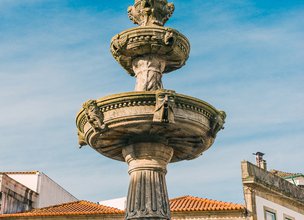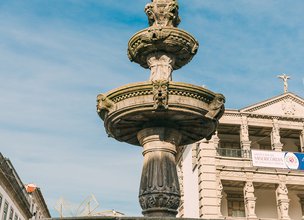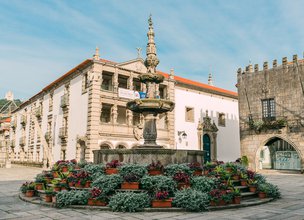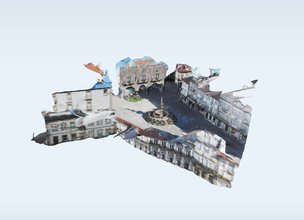(National Monument) Mannerist infrastructural architecture. Central fountain with a circular designed tank, formed by slabs externally decorated with concave and denticulate cushions, emphasis columns decorated with different plant-inspired motifs and two bowls, also circular, with several moldings and a denticulate frieze, finished in a vegetal pyramid, in a clear pyramidal scheme. Together with the Porto (1544), Pontevedra (1549) and Caminha (1551) fountains, it became the prototype of a public fountain funded by the municipality during the mid-16th century. A fountain of great decorative wealth, constituting almost a copy of the one in Caminha, by the same bricklayer, and which served as a model of construction according to the contract, having on the base frieze the date of completion. The similarities are evident even in the protective railing that disappeared at the beginning of the 20th century of Viana’s fountain, but the one in Caminha is still preserved. Together with that fountain and that of Pontevedra, it is one of the most representative works of João Lopes' career, being the three largest, with a clear urban character and iconographic sense. Even though the plumbing works took a long time, the fountain itself was built in a year or two, perhaps due to João Lopes' experience in this type of construction.
(National Monument) Mannerist infrastructural architecture. Central fountain with a circular designed tank, formed by slabs externally decorated with concave and denticulate cushions, emphasis columns decorated with different plant-inspired motifs and two bowls, also circular, with several moldings and a denticulate frieze, finished in a vegetal pyramid, in a clear pyramidal scheme. Together with the Porto (1544), Pontevedra (1549) and Caminha (1551) fountains, it became the prototype of a public fountain funded by the municipality during the mid-16th century. A fountain of great decorative wealth, constituting almost a copy of the one in Caminha, by the same bricklayer, and which served as a model of construction according to the contract, having on the base frieze the date of completion. The similarities are evident even in the protective railing that disappeared at the beginning of the 20th century of Viana’s fountain, but the one in Caminha is still preserved. Together with that fountain and that of Pontevedra, it is one of the most representative works of João Lopes' career, being the three largest, with a clear urban character and iconographic sense. Even though the plumbing works took a long time, the fountain itself was built in a year or two, perhaps due to João Lopes' experience in this type of construction.
Location
Praça da República, Viana do Castelo
Coordinates
Lat: 41.6935833
Long: -8.8283056
Hello little one!
I'm Piquinhos and I can help you learn more about the Geopark!
Technical details
Child Mode
Discover the geopark in a simpler format, aimed at the little ones.
Clique ENTER para pesquisar ou ESC para sair





